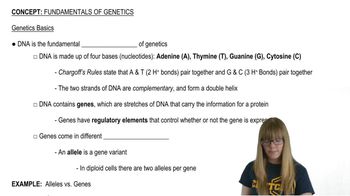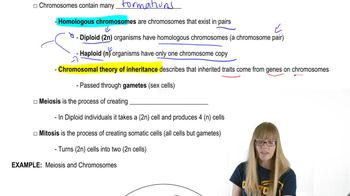Table of contents
- 1. Introduction to Genetics51m
- 2. Mendel's Laws of Inheritance3h 37m
- 3. Extensions to Mendelian Inheritance2h 41m
- 4. Genetic Mapping and Linkage2h 28m
- 5. Genetics of Bacteria and Viruses1h 21m
- 6. Chromosomal Variation1h 48m
- 7. DNA and Chromosome Structure56m
- 8. DNA Replication1h 10m
- 9. Mitosis and Meiosis1h 34m
- 10. Transcription1h 0m
- 11. Translation58m
- 12. Gene Regulation in Prokaryotes1h 19m
- 13. Gene Regulation in Eukaryotes44m
- 14. Genetic Control of Development44m
- 15. Genomes and Genomics1h 50m
- 16. Transposable Elements47m
- 17. Mutation, Repair, and Recombination1h 6m
- 18. Molecular Genetic Tools19m
- 19. Cancer Genetics29m
- 20. Quantitative Genetics1h 26m
- 21. Population Genetics50m
- 22. Evolutionary Genetics29m
1. Introduction to Genetics
Fundamentals of Genetics
Problem 6a
Textbook Question
Contrast chromosomes and genes.
 Verified step by step guidance
Verified step by step guidance1
Understand that chromosomes are long strands of DNA that contain many genes, along with regulatory elements and other nucleotide sequences.
Recognize that genes are specific sequences of DNA that code for proteins or functional RNA molecules, and they are located on chromosomes.
Note that humans typically have 23 pairs of chromosomes, with each chromosome containing hundreds to thousands of genes.
Consider that chromosomes are visible under a microscope during cell division, while genes are not visible as they are part of the DNA sequence.
Remember that while chromosomes are structures that organize and package DNA, genes are the functional units of heredity that determine specific traits.
Recommended similar problem, with video answer:
 Verified Solution
Verified SolutionThis video solution was recommended by our tutors as helpful for the problem above
Video duration:
2mPlay a video:
Was this helpful?
Key Concepts
Here are the essential concepts you must grasp in order to answer the question correctly.
Chromosomes
Chromosomes are long, thread-like structures made of DNA and proteins that carry genetic information. In humans, there are 23 pairs of chromosomes, with one set inherited from each parent. They play a crucial role in cell division, ensuring that DNA is accurately replicated and distributed to daughter cells. Chromosomes are visible under a microscope during cell division, appearing as distinct entities.
Recommended video:
Guided course

Chromosome Structure
Genes
Genes are specific sequences of DNA located on chromosomes that encode instructions for building proteins, which perform various functions in the body. Each gene can influence traits and characteristics, such as eye color or susceptibility to certain diseases. Genes are the fundamental units of heredity, passed from parents to offspring, and can vary in different alleles, contributing to genetic diversity.
Recommended video:
Guided course

Mapping Genes
Relationship between Chromosomes and Genes
The relationship between chromosomes and genes is foundational in genetics, as genes are segments of DNA found within chromosomes. Each chromosome contains many genes, and the organization of these genes on chromosomes determines how traits are inherited. Understanding this relationship is essential for studying genetic inheritance, mutations, and the overall functioning of an organism's genome.
Recommended video:
Guided course

Chromosome Structure

 8:55m
8:55mWatch next
Master Genetics Basics with a bite sized video explanation from Kylia Goodner
Start learning



